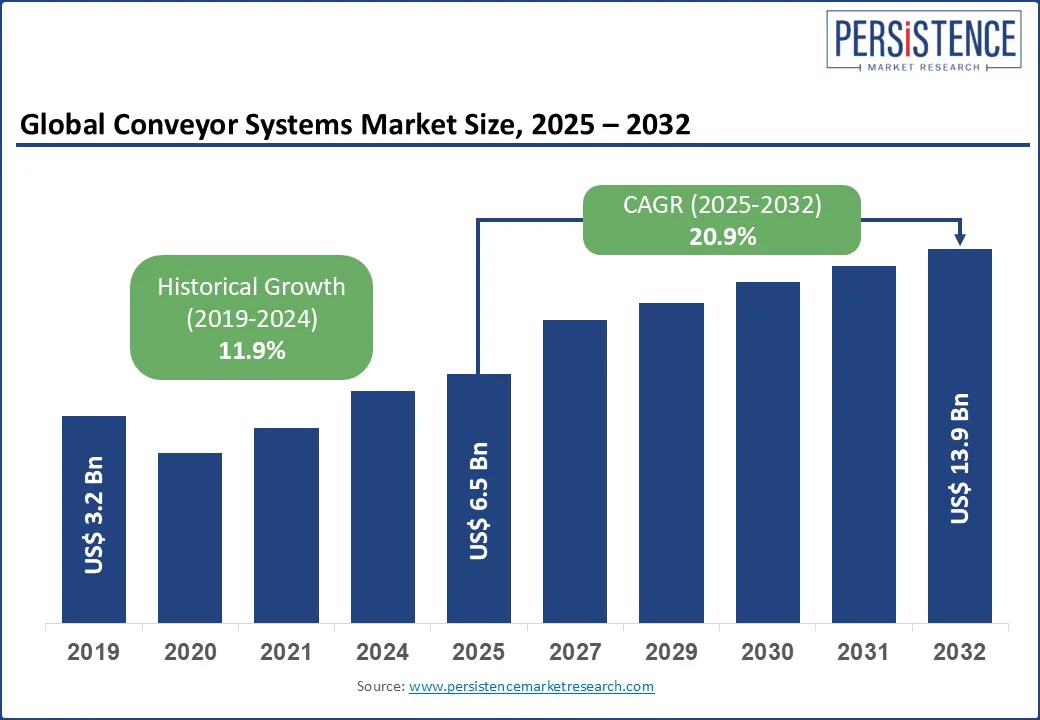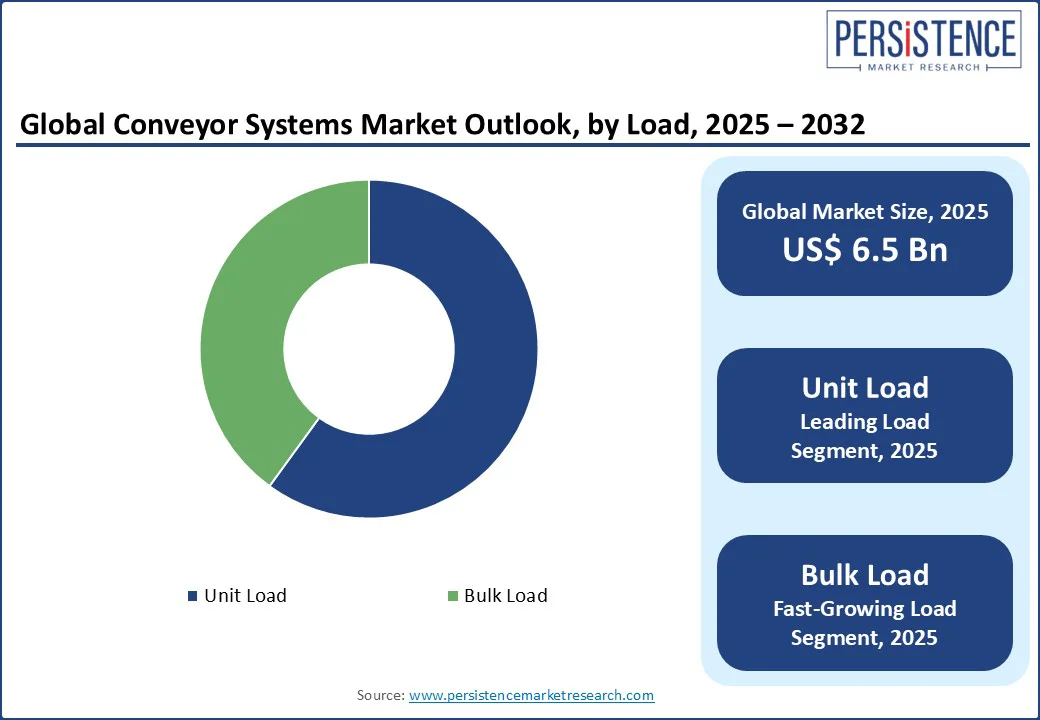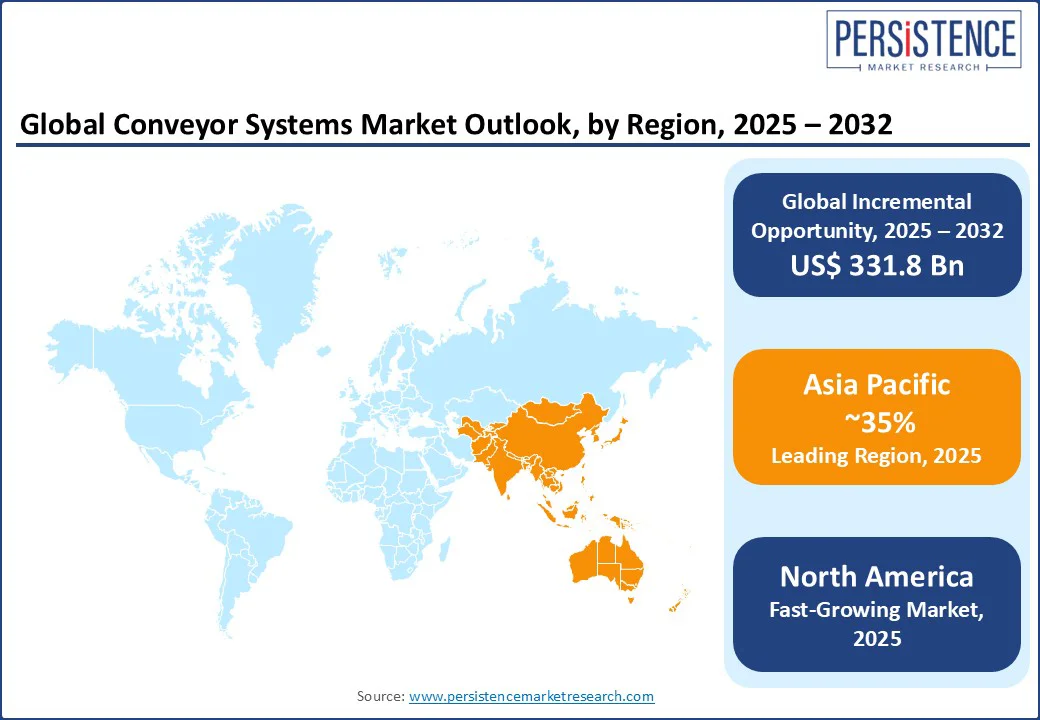ID: PMRREP4714| 175 Pages | 18 Aug 2025 | Format: PDF, Excel, PPT* | Industrial Automation

The global conveyor systems market size is likely to be valued at US$ 6.5 Bn in 2025 and is expected to reach US$ 13.9 Bn by 2032, growing at a robust CAGR of 20.9% during the forecast period 2025 - 2032.
The conveyor system indsutry is driven by increasing demand for conveyor systems, material handling conveyor, and automated conveyors. Key players such as Daifuku Co. Ltd., Siemens AG, and KION Group AG are leveraging innovations in smart conveyor systems with IoT integration, conveyor systems in food and beverage industry, and energy-efficient conveyor solutions to enhance operational efficiency.

Key Industry Highlights
|
Global Market Attribute |
Key Insights |
|
Conveyor Systems Market Size (2025E) |
US$ 6.5 Bn |
|
Market Value Forecast (2032F) |
US$ 13.9 Bn |
|
Projected Growth (CAGR 2025 to 2032) |
20.9% |
|
Historical Market Growth (CAGR 2019 to 2024) |
11.9% |
The conveyor systems market is propelled by several key factors, with a significant focus on the rapid growth of e-commerce and warehouse automation. The global e-commerce market expanded by 25% in 2025, driving demand for logistics conveyor systems and package handling conveyors to streamline order fulfilment.
A 2025 industry report noted that 70% of e-commerce warehouses globally adopted automated conveyors to handle increased order volumes, with companies such as Amazon and Alibaba investing US$ 50 Bn in warehouse automation infrastructure.
Smart conveyor systems with IoT integration enhance real-time tracking and efficiency, reducing delivery times by 20%. The conveyor systems in food and beverage industry also benefit, with 50% of food processing plants using material handling conveyor systems to ensure hygiene and speed, per FDA data.
Robotics in material handling, integrated with sorting and scanning systems, boosts throughput by 30%, particularly in supply chain & logistics. The industrial transport systems and automated material transport systems, supported by US$ 200 Bn in global logistics investments in 2025, per UNCTAD, further drive conveyor market growth, aligning with Industry 4.0 trends.
High installation and maintenance costs pose a significant restraint to the conveyor systems market, impacting conveyor system installation and the adoption of advanced systems. Smart conveyor systems with IoT integration and automated conveyors require sophisticated components such as sensors and robotics, increasing conveyor system installation costs by 25-30% compared to traditional systems, per a 2025 industry report. Material handling conveyor maintenance, particularly for bulk material conveyors in mining, incurs 15% higher costs due to wear and tear.
Small and medium enterprises in emerging markets such as India and Africa face barriers, with 40% opting for manual systems to avoid high capital expenditure. Supply chain disruptions for components, with 10% cost increases in 2025 further challenge conveyor system manufacturing, limiting the scalability of energy-efficient conveyor solutions and industrial transport systems in cost-sensitive regions.
The advancements in smart conveyor technology present a significant opportunity for the Conveyor Systems Market, driven by Industry 4.0 and sustainability trends. Smart conveyor systems with IoT integration enable predictive maintenance and real-time data analytics, reducing downtime by 25%, per a 2025 report. The global warehouse automation market is projected to grow at a CAGR of 15% through 2032 due to increasing demand for sorting and scanning systems and robotics in material handling.
Companies such as Siemens AG are investing US$ 300 Mn in R&D for energy-efficient conveyor solutions, enhancing efficiency in logistics conveyor systems and package handling conveyors. The conveyor systems in the food and beverage industry, with 20% adoption growth in 2025 for hygienic flat belt conveyors, benefit from smart conveyor technology. Emerging markets, with 1.5 Bn new warehouse units projected by 2030, per UNIDO, offer opportunities for automated material transport systems and goods handling conveyors, positioning smart conveyor technology as a key growth driver.
Roller conveyors hold approximately 40% of the market share in 2025 due to their versatility in material handling conveyor applications across supply chain & logistics and manufacturing. Roller systems dominate package handling conveyors, with 60% adoption in e-commerce warehouses in 2025.
Vertical conveyors are driven by warehouse automation and space optimization in logistics conveyor systems, with 20% growth in 2025. This growth is strongly tied to the boom in e-commerce and omnichannel retail, where order fulfilment speed and storage efficiency directly influence profitability.
On-Floor conveyors command a 50% market share in 2025, driven by goods handling conveyors in supply chain & logistics and manufacturing, with 70% adoption in large-scale facilities in 2025. These systems are favored for their ease of installation, scalability, and compatibility with automation technologies such as barcode scanners, sortation units, and robotic pickers.
Overhead conveyors are fueled by automated material transport systems in pharmaceuticals and food & beverages, with 15% growth in 2025. Their integration with automated sorting, tracking, and cleaning systems further boosts efficiency, reduces labor dependency, and enhances compliance with industry-specific standards.
Unit Load holds a 60% market share in 2025, driven by package handling conveyors and sorting and scanning systems in supply chain & logistics, with 65% adoption in e-commerce in 2025. Bulk Load is fueled by bulk material conveyors in mining and manufacturing, with 18% growth in 2025. In manufacturing, they handle raw materials such as cement, sand, and chemicals in high-capacity production lines, ensuring steady supply to processing units.
Supply Chain & Logistics holds a 35% market share in 2025, driven by logistics conveyor systems and warehouse automation, with 70% of e-commerce facilities using automated conveyors in 2025. These systems enable efficient sorting, transporting, and distribution of goods within warehouses and fulfillment centers, supporting just-in-time delivery models.
Food & Beverages are fueled by conveyor systems in food and beverage industry and energy-efficient conveyor solutions, with 20% growth in 2025. These systems support diverse applications-from transporting raw ingredients and finished products to automating sorting and quality control.

In North America, the Conveyor Systems Market holds a distinct position, commanding a 30% market share in 2025. The U.S. dominates due to its advanced supply chain & logistics and warehouse automation sectors. The U.S. market grows at a CAGR of 21.5%, driven by package handling conveyors and smart conveyor systems with IoT integration, with 80% of e-commerce warehouses using automated conveyors in 2025, per industry data.
Robotics in material handling and sorting, and scanning systems grow by 25% annually, supported by companies such as Amazon. Energy-efficient conveyor solutions reduce costs by 15%. Daifuku Co. Ltd. and Siemens AG drive 25% of regional revenue, leveraging conveyor system installation and industrial transport systems.
In Europe, the Conveyor Systems Market accounts for a 25% market share, led by Germany, the UK, and France. Germany’s market is driven by manufacturing and logistics conveyor systems, with 60% of automotive plants using roller conveyors in 2025, per industry data. The EU’s Industry 4.0 initiatives boost smart conveyor technology, with 20% growth in robotics in material handling. The UK’s food & beverages sector supports a with conveyor systems in the food and beverage industry adopted by Nestlé. France’s pharmaceuticals sector drives 15% growth in vertical conveyors. €200 Mn in EU funding for automation in 2025 enhances automated material transport systems.
Asia Pacific is the most prominently growing region, holding 35% market share, led by China, Japan, and India. China holds a 40% regional market share, driven by a 30% increase in warehouse automation in 2025, boosting logistics conveyor systems and package handling conveyors. Japan’s market is fueled by manufacturing and smart conveyor systems with IoT integration, with 25% growth in sorting and scanning systems. India’s market is driven by food & beverages and bulk material conveyors, with 90% of new warehouses using automated conveyors in 2025. Energy-efficient conveyor solutions and conveyor market growth, supported by US$ 40 Bn in logistics investments by 2030, drive innovation.

The global conveyor systems market is marked by fierce competition, with automation companies competing on innovation, efficiency, and sustainability. Daifuku Co. Ltd. and Siemens AG dominate in smart conveyor technology, while KION Group AG leads in logistics conveyor systems. Automated conveyors, robotics in material handling, and energy-efficient conveyor solutions add a competitive layer. Strategic partnerships and R&D investments in sorting and scanning systems are key differentiators.
The conveyor system market is projected to reach US$ 6.5 Bn in 2025.
E-commerce growth, warehouse automation, and smart conveyor systems with IoT integration are key drivers.
The conveyor system market is likely to grow at a CAGR of 20.9% from 2025 to 2032, reaching US$ 13.9 Bn by 2032.
Opportunities include smart conveyor technology, energy-efficient conveyor solutions, and expansion in food & beverages.
Key players include Daifuku Co. Ltd., Siemens AG, KION Group AG, FlexLink AB, Interroll Holding AG, SSI Schaefer AG, BEUMER Group GmbH & Co. KG, Fives Group, and Taikisha Ltd.
|
Report Attribute |
Details |
|
Historical Data/Actuals |
2019 - 2024 |
|
Forecast Period |
2025 - 2032 |
|
Units |
Value: US$ Bn, Volume: As Applicable |
|
Geographical Coverage |
|
|
Segmental Coverage |
|
|
Competitive Analysis |
|
|
Report Highlights |
|
|
Customization and Pricing |
Available upon request |
By Product Type
By Location
By Load
By Application
By Region
Delivery Timelines
For more information on this report and its delivery timelines please get in touch with our sales team.
About Author